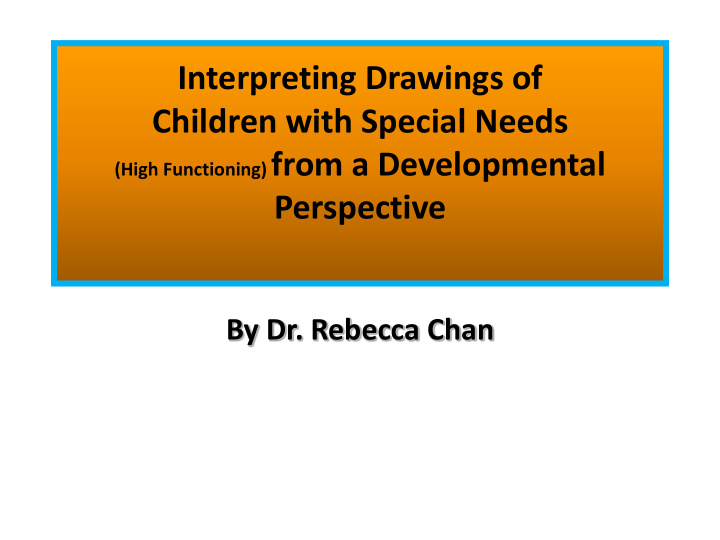



Interpreting Drawings of Children with Special Needs (High Functioning) from a Developmental Perspective By Dr. Rebecca Chan
Introduction • She is the Principal Education Development Specialist, Specialist Headquarter of NTUC First Campus • She was an adjunct lecturer with the SEED Institute in Early Childhood Education • She was an adjunct lecturer with the National Institute of Education / Nanyang Technological University (NIE/NTU)in Art Education , Visual and Performing Arts department. • She is an outstanding researcher and presenter in conferences, talks and workshops in Singapore and the United Kingdom. • She will be speaking at the National Association for the Education of Young Children (NAEYC) 2014 Nov 5 -8 Annual Conference & Expo, Dallas, Texas
17 child-artists with special needs (5-6 years old) 34 Drawings (Pre and post-lesson drawings)
Drawing Themes 1. How do you come to school everyday 2. Things in a classroom 3. National day 4. Friends in the school (Racial harmony day) 5. What I like to do in school 6. Number-story Special Needs Domains • Global Developmental Delay (GDD) • Speech delay • Autism Spectrum Disorder (ASD) • Asperger
Drawing develops thinking & learning “ Thought Development ” activity for young children (Hope, 2008, p.67)
Bloom’s Taxonomy of Educational Objectives 4 Types of 6 Cognitive processes Knowledge • Factual • Remember • Conceptual • Understand • Procedural • Apply • Metacognitive • Analyze • Evaluate • Create
Things in the classroom
National Day Drawings
What I like to do in class…
Special Needs Teachers’ Comments “Yes, it is useful as it really makes you look at the drawing as a mirror of the child’s intent and thoughts.” “It really makes you think and try to analyse what we might overlooked when looking at child’s drawing.” “… can apply and refer as guide for lesson planning, intervention, strategies etc. Catering to the individual needs of their students.”
Special Needs Teachers’ comments “It helps break down the analysis of children’s drawings into steps; easy to organize thoughts.” “The checklist is very good to help me know how to categorize their thinking; to stir me to promote higher level of learning/thinking; to appreciate the drawings and use them more effectively for their growth.”
Thank you. drawrebecca@gmail.com
Recommend
More recommend